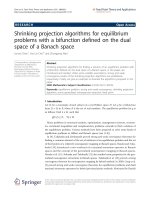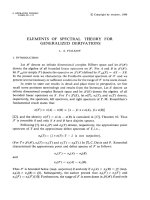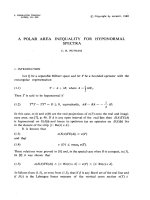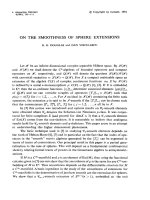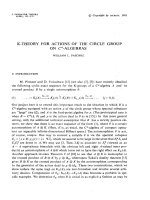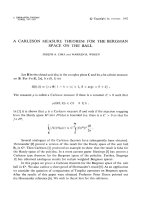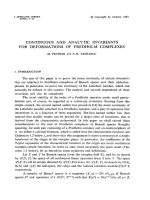Báo cáo toán học: "New Lower Bound Formulas for Multicolored Ramsey Numbers" pptx
Bạn đang xem bản rút gọn của tài liệu. Xem và tải ngay bản đầy đủ của tài liệu tại đây (89.66 KB, 6 trang )
New Lower Bound Formulas for
Multicolored Ramsey Numbers
Aaron Robertson
Department of Mathematics
Colgate University, Hamilton, NY 13346
Submitted: July 26, 2001; Accepted: March 18, 2002
MR Subject Classification: 05D10
Abstract
We give two lower bound formulas for multicolored Ramsey numbers. These formu-
las improve the bounds for several small multicolored Ramsey numbers.
1. INTRODUCTION
In this short article we give two new lower bound formulas for edgewise r-colored
Ramsey numbers, R(k
1
,k
2
, ,k
r
), r ≥ 3, defined below. Both formulas are derived via
construction.
We will make use of the following notation. Let G be a graph, V (G)thesetofvertices
of G,andE(G) the set of edges of G.Anr-coloring, χ, will be assumed to be an edgewise
coloring, i.e. χ(G):E(G) →{1, 2, ,r}.Ifu, v ∈ V (G), we take χ(u, v)tobethecolor
of the edge connecting u and v in G.WedenotebyK
n
thecompletegraphonn vertices.
Definition 1.1 Let r ≥ 2.Letk
i
≥ 2, 1 ≤ i ≤ r. The number R = R(k
1
,k
2
, ,k
r
) is
defined to be the minimal integer such that any edgewise r-coloring of K
R
must contain,
for some j, 1 ≤ j ≤ r, a monochromatic K
k
j
of color j. If we are considering the
diagonal Ramsey numbers, i.e. k
1
= k
2
= ··· = k
r
= k, we will use R
r
(k) to denote the
corresponding Ramsey number.
The numbers R(k
1
,k
2
, ,k
r
) are well-defined as a result of Ramsey’s theorem [Ram].
Using Definition 1.1 we make the following definition.
the electronic journal of combinatorics 9 (2002), #R13 1
Definition 1.2 ARamseyr-coloring for R = R(k
1
,k
2
, ,k
r
) is an r-coloring of the
complete graph on V<Rvertices which does not admit any monochromatic K
k
j
subgraph
of color j for j =1, 2, ,r.ForV = R − 1 we call the coloring a maximal Ramsey
r-coloring.
2. THE LOWER BOUNDS
We start with an easy bound which nonetheless improves upon some current best lower
bounds.
Theorem 2.1 Let r ≥ 3. For any k
i
≥ 3, i =1, 2, ,r, we have
R(k
1
,k
2
, ,k
r
) > (k
1
− 1)(R(k
2
,k
3
, ,k
r
) − 1).
Proof. Let φ(G) be a maximal Ramsey (r − 1)-coloring for R(k
2
,k
3
, ,k
r
) with colors
2, 3, ,r.Letk
1
≥ 3. Define graphs G
i
, i =1, 2, ,k
1
− 1, with |V (G
i
)| = |V (G)| on
distinct vertices (from each other), each with the coloring φ.LetH bethecompletegraph
on the vertices V (H)=∪
k
1
−1
i=1
V (G
i
). Let v
i
∈ G
i
, v
j
∈ G
j
and define χ(H) as follows:
χ(v
i
,v
j
)=
φ(v
i
,v
j
)ifi = j
1ifi = j.
We now show that χ(H) is a Ramsey r-coloring for R(k
1
,k
2
, ,k
r
). For j ∈{2, 3, ,r},
χ(H) does not admit any monochromatic K
k
j
of color j by the definition of φ. Hence, we
need only consider color 1. Since φ(G
i
), 1 ≤ i ≤ k
1
− 1, is void of color 1, any monochro-
matic K
k
1
ofcolor1mayonlyhaveonevertexinG
i
for 1 ≤ i ≤ k
1
− 1. By the pigeonhole
principle, however, there exists x ∈{1, 2, ,k
1
− 1} such that G
x
contains two vertices
of K
k
1
, a contradiction. ✷
Examples. Theorem 2.1 implies that R
5
(4) ≥ 1372,R
5
(5) ≥ 7329,R
4
(6) ≥ 5346, and
R
4
(7) ≥ 19261, all of which beat the current best known bounds given in [Rad].
We now look at an off-diagonal bound. This uses and generalizes methods found in
[Chu] and [Rob].
Theorem 2.2 Let r ≥ 3. For any 3 ≤ k
1
<k
2
, and k
j
≥ 3, j =3, 4, ,r, we have
R(k
1
,k
2
, ,k
r
) > (k
1
+1)(R(k
2
− k
1
+1,k
3
, ,k
r
) − 1).
Before giving the proof of this theorem, we have need of the following definition.
the electronic journal of combinatorics 9 (2002), #R13 2
Definition 2.3 We say that the n × n symmetric matrix
T = T(x
0
,x
1
, ,x
r
)=(a
ij
)
1≤i,j≤n
is a Ramsey incidence matrix for R(k
1
,k
2
, ,k
r
) if T is obtained by using a Ramsey
r-coloring for R(k
1
,k
2
, ,k
r
), χ : E(K
n
) →{x
1
,x
2
, ,x
r
}, as follows. Define a
ij
=
χ(i, j) if i = j and a
ii
= x
0
.
From Definition 2.3 we see that an n × n Ramsey incidence matrix T (x
0
,x
1
, ,x
r
)
for R(k
1
,k
2
, ,k
r
) gives rise to an r-colored K
n
which does not contain K
k
i
of color x
i
for i =1, 2, ,r.
Proof of Theorem 2.2. We will be using Ramsey incidence matrices to construct an
r-colored Ramsey graph on (k
1
+1)(R(k
2
− k
1
+1,k
3
, ,k
r
) − 1) vertices which does not
admit monochromatic subgraphs K
k
i
of color i, i =1, 2, ,r. We start the proof with
R(t, k, l) and then generalize to an arbitrary number of colors.
Let l>tand consider a maximal Ramsey 2-coloring for R = R(k, l − t + 1). Let T =
T (x
0
,x
1
,x
2
) denote the associated Ramsey incidence matrix. Define A = A
= T (0, 2, 3),
B = B
= T (3, 2, 1), and C = T (1, 2, 3), and consider the symmetric (t +1)(R − 1) × (t +
1)(R −1) matrix, M, below (so that there are t+ 1 instances of T in each row and in each
column). We note that in the definitions of A and A
we have the color 0 present. This is
valid since, as M is defined in equation (1), the color 0 only occurs on the main diagonal of
M and the main diagonal entries correspond to nonexistent edges in the complete graph.
AB
CC C ··· C
B
A
CC C ··· C
CCABB··· B
M = CCBAB··· B
CCBBA
.
.
.
.
.
.
.
.
.
.
.
.
.
.
.
.
.
.
.
.
.
.
.
.
B
C C B B B A
(1)
We will show that M defines a 3-coloring which contains no monochromatic K
t
of
color 1, no monochromatic K
k
of color 2, and, for l>t, no monochromatic K
l
of color 3,
to show that R(t, k, l) > (t +1)(R(k, l − t +1)− 1).
Note 1: We will use the phrase diagonal of X,whereX = A, A
,B,B
, or C,tomean
the diagonal of X when X is viewed as a matrix by itself.
Note 2: For ease of reading, we will use (i, j) to represent the matrix entry a
ij
.
No monochromatic K
t
of color 1.LetV (K
t
)={i
1
,i
2
, ,i
t
} with i
1
<i
2
< ···<i
t
,
so that we can view E(K
t
) as corresponding to the entries in M given by ∪
j>k
(i
j
,i
k
).
the electronic journal of combinatorics 9 (2002), #R13 3
We now argue that not all of these entries can be equal to 1. Assume, for a contradiction,
that all entries are equal to 1.
First, we cannot have two distinct entries in the collection of C’s. Assume otherwise
and let (i
j
1
,i
k
1
)and(i
j
2
,i
k
2
)bothbeinthecollectionofC’s with either i
j
1
= i
j
2
or
i
k
1
= i
k
2
.
Case I. (i
j
1
= i
j
2
)Leti
j
1
<i
j
2
. Note that the entry 1 occurs only on the diagonal of C.
We have two subcases to consider.
Subcase i. (i
k
1
= i
k
2
) In this subcase, (i
j
2
,i
j
1
) is on the diagonal of B, a contradiction.
Subcase ii. (i
k
1
= i
k
2
) In this subcase, one of (i
j
1
,i
k
2
), (i
j
2
,i
k
1
) is not on the diagonal
of C, but is in C, a contradiction.
Case II. (i
j
1
= i
j
2
and i
k
1
= i
k
2
) Letting i
k
1
<i
k
2
forces (i
k
2
,i
k
1
) to be on the diagonal of
B
, a contradiction.
The above cases show that we can have at most one entry in the collection of C’s.
Next, since A does not contain 1, we must have at least
t
2
−1 entries in the collection
of B’s (including B
). If there exists an entry in B
then, since we can have at most one
entry in the collection of C’s, we must have all of the entries ∪
k<j <t
(i
j
,i
k
)inB
.Since
t ≥ 3, we must have 1 = (i
t−1
,i
t−2
) ∈ A
, a contradiction. Hence, there cannot exist an
entry in B
.
Thus, we must have
t
2
− 1 entries in the collection of B’s, but not in B
.Now,ifwe
assume that (i
j
1
,i
k
1
)and(i
j
2
,i
k
2
), i
j
1
<i
j
2
, are both in the same B, then we must have
(i
j
2
,i
j
1
) ∈ A, a contradiction. Furthermore, we cannot have i
j
1
= i
j
2
since this implies
that (i
k
2
,i
k
1
) ∈ A. Hence, each B contains at most one entry for a total of at most
t−1
2
entries. Since
t−1
2
<
t
2
− 1 for t ≥ 3, we cannot have all entries equal to 1, and hence
we cannot have a monochromatic K
t
of color 1.
No monochromatic K
k
of color 2. For this case we will use the following lemma.
Lemma 2.3 Let S(x
0
,x
1
, ,x
r
) be a Ramsey incidence matrix for R(k
1
,k
2
, ,k
r
).Let
N be a block matrix defined by instances of S (for example, equation (1)). For y ≥ 3,let
V (K
y
)={i
1
,i
2
, ,i
y
} with i
1
<i
2
< ··· <i
y
so that we can associate with E(K
y
) the
entries of N given by ∪
j>k
(i
j
,i
k
).Fixx
f
for some 1 ≤ f ≤ r.Ifx
f
=(i
j
,i
k
) for all
1 ≤ k<j≤ y, and x
f
as an argument of S is in the same (argument) position, but not
the first (argument) position, for all instances of S then y<k
f
.
Proof. Let m = R(k
1
, ,k
r
)−1. By assumption of identical argument positions of x
f
in all instances of S, for any entry (i, j)=x
f
we must have (i (mod m),j(mod m)) = x
f
.
Provided all (i
j
(mod m),i
k
(mod m)), 1 ≤ k<j≤ y, are distinct, this would imply that
a monochromatic K
y
of color f exists in a maximal Ramsey r-coloring for R(k
1
, ,k
r
),
the electronic journal of combinatorics 9 (2002), #R13 4
thus giving y<k
f
.
It remains to show that all (i
j
(mod m),i
k
(mod m)), 1 ≤ k<j≤ y,aredistinct.
Assume not and consider (i
j
1
,i
k
1
)and(i
j
2
,i
k
2
) with either i
j
1
= i
j
2
or i
k
1
= i
k
2
.
Case I. (i
j
1
= i
j
2
)Leti
j
1
<i
j
2
.Sincei
j
1
≡ i
j
2
(mod m) this implies that (i
j
2
,i
j
1
)mustbe
on the diagonal of some instance of S, a contradiction, since the first argument denotes
the diagonal, and all entries are not on the diagonal of any instance of S.
Case II. (i
k
1
= i
k
2
)Leti
k
1
<i
k
2
.AsinCaseI,thisimpliesthat(i
k
2
,i
k
1
) must be on the
diagonal of some instance of S, a contradiction. ✷
Applying Lemma 2.3 with N = M, S = T ,andf = 2 we see that we cannot have a
monochromatic K
k
of color 2.
No monochromatic K
l
of color 3.LetV (K
l
)={i
1
,i
2
, ,i
l
} with i
1
<i
2
< ···<i
l
,
so that we can view E(K
l
) as corresponding to the entries in M given by ∪
j>k
(i
j
,i
k
). We
now argue that not all of these entries can be equal to 3. Suppose, for a contradiction,
that all of these entries are equal to 3.
If there are no entries in the collection of B’s (including B
), then by Lemma 2.3 (with
N = M, S = T ,andf =3)wemusthavel<l− t + 1, a contradiction. Hence, there
exists an entry in some B or B
.
Next, note that 3 only occurs on the diagonals of B and B
. Thus, we cannot have
(i
j
1
,i
k
1
)and(i
j
2
,i
k
2
), i
j
1
<i
j
2
,bothbeinthesameB or the same B
, for otherwise
(i
j
2
,i
k
1
) is not on the diagonal of B or B
, a contradiction. Hence, each B and B
contains at most one entry.
Consider the complete subgraph K
l−t+1
of K
l
on the vertices {i
2
,i
3
, ,i
l−t+2
},sothat
we can view E(K
l−t+1
) as corresponding to the entries in M given by ∪
l−t+2≥j>k≥2
(i
j
,i
k
).
By construction, none of these entries are in the collection of B’s and B
’s. To see this,
note that we may have (i
k
,i
1
) ∈ B
for at most one 2 ≤ k ≤ t and we may have (i
k
,i
j
) ∈ B
for each l − (t − 2)+1≤ k ≤ l for at most one 1 ≤ j<k(i.e. one entry in each of
the bottom t − 2rowsofM). Hence, none of the edges of K
l−t+1
on { i
2
, ,i
l−t+2
} are
associated with an entry in B or B
.
Applying Lemma 2.3 (with N = M, S = T ,andf =3)wegetl − t +1<l− t +1,a
contradiction. Thus, no monochromatic K
l
of color 3 exists.
The full theorem. To generalize the above argument to an arbitrary number of
colors we change the definitions of A, A
, B, B
,andC; A = A
= T (0, 2, 3, 4, 5, ,r),
B = B
= T (3, 2, 1, 4, 5, ,r), C = T (1, 2, 3, 4, 5, ,r). To see that there is no
monochromatic K
k
j
of color j for j =4, 5, ,r, see the argument for no monochro-
matic K
k
of color 2 above. ✷
the electronic journal of combinatorics 9 (2002), #R13 5
Example. Theorem 2.2 implies that R(3, 3, 3, 11) ≥ 437, beating the previous best lower
bound of 433 as given in [Rad].
Acknowledgment. I thank an anonymous referee for suggestions which drastically im-
proved the presentation of this paper.
REFERENCES
[Chu] F. Chung, On the Ramsey Numbers N (3, 3, ,3; 2), Discrete Mathematics 5 (1973), 317-321.
[Rad] S. Radziszowski, Small Ramsey Numbers, Electronic Journal of Combinatorics, DS1 (revision #8,
2001), 38pp.
[Ram] F. Ramsey, On a Problem of Formal Logic, Proceedings of the London Mathematics Society 30
(1930), 264-286.
[Rob] A. Robertson, Ph.D. thesis, Temple University, 1999.
the electronic journal of combinatorics 9 (2002), #R13 6

